#solar powered electric boat
Text
100% Solar Electric Boat
100% Solar Electric Boat
youtube
View On WordPress
#aditya solar boat#aditya solar ferry#Boat#electric boat#electric boat in india#first solar boat in kerala#india&039;s first solar electric boat#indian solar boats#solar#Solar Boat#solar boat project#solar boats#solar electric boat#Solar Energy#solar ferry#solar fishing boat#Solar Power#solar power boats#Solar powered boat#the first solar boat in india#Youtube
0 notes
Text
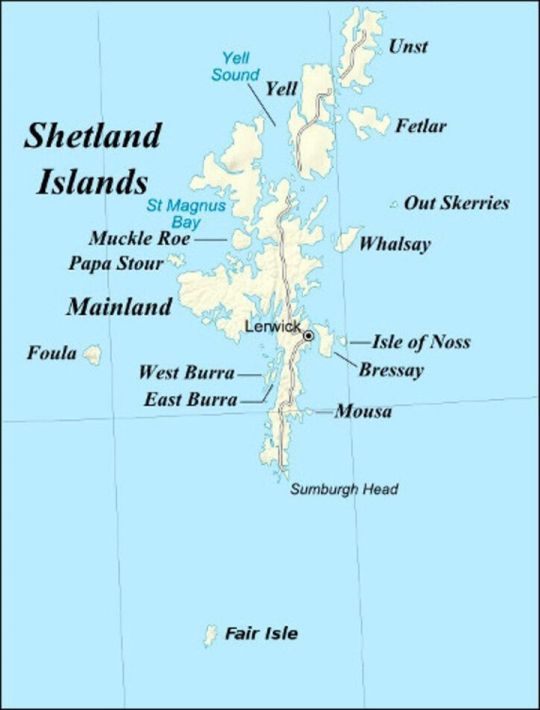


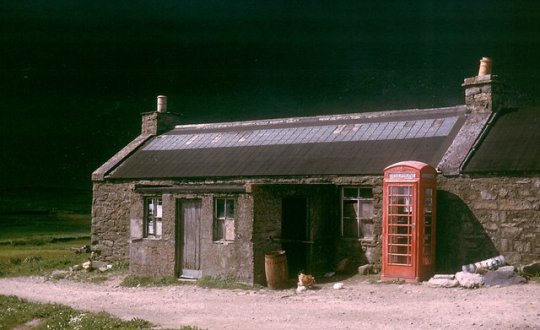

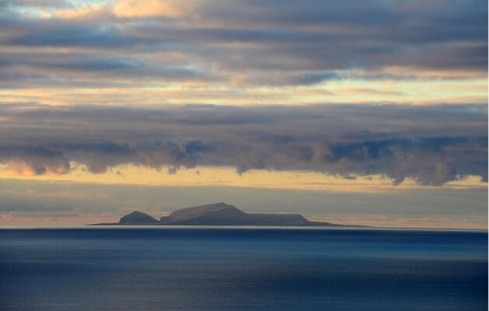


On March 3rd 1883 three hundred inhabitants of the remote Shetland island of Foula were on the point of starvation as the first supply boat of the year reached the stormbound community.
Foula, often described as the "Edge Of The World" is our most remote inhabited island. It is situated in the Atlantic Ocean approximately 20 miles to the west of the Shetland mainland. It is an island of crofting townships, breath-taking sheer cliff drops, and a wealth of wild flowers and wildlife.
Over a century ago, in 1881, Foula had a population of 267, mostly employed in fishing...at the last census in 2001 that figure had dropped to just 38.
On March 3rd 1883 the Shetland Times published this;
The Weather and Mails – Foula
Nine weeks have now expired since our last mail was landed, and all our resources are almost exhausted. Sugar and tobacco have been all done for more than a fortnight, and tea, coffee, etc, are now done also. Those who had a little meal to spare have helped those who had none, a thing often done in Foula, but if the weather does not moderate we will soon be all alike. The boat has been in readiness now for some time to go to Walls for supplies, and as the weather has become a little more moderate today they are going to make a start, so we hope that they may get safe through, and a chance to return again soon. But we doubt if the mail boat will be able to cross today yet, as the wind still inclines to the westward.
There isn’t much more than this about their plight, but it seems that same day they breathed a sigh of relief as a boat must have made it to Mainland and back successfully.
Today crofting as well as fishing are the main activities, half the population living at Hametoun in the south east and the remainder to be found at Ham near Ham Voe on the east coast. The island is not connected to any mainland electricity grid system. In 1987 a community electricity scheme was constructed, comprising a 3.3kV island grid which linked diesel generators, a wind turbine and a hydroelectricity scheme to the island’s properties. This scheme gradually fell into disrepair and has undergone a major refurbishment, funded primarily through grants.
Before refurbishment, the entire island's power was supplied by one of the two diesel generators which operated between approximately 7.20am and 00.30am. That’s not to say they were without power for the, just under 7 hours the generator is off, a battery/inverter system was installed between 2006 and January 2007, a solar charging array helps top up the batteries as well . The system was fully commissioned at the beginning of March 2007 and already the islanders not only have continuous power ( instead of the previous 17 hours per day) but are noticing considerable savings in diesel fuel use. Since diesel has to be shipped in by ferry (and often the weather is too bad for the ferry to run for up to 3 weeks on end) this of huge value.
An interesting feature of the island's people is that they still observe the old Julian calendar, replaced in 1752 in Britain by the present Gregorian system which deleted 11 days from the year. Remote areas of the country kept to the old calendar, adding an extra day in 1800, which was a leap year, and some parts of Shetland continued to observe festivals 12 days after the dates in the new calendar. The most remote areas kept to the old calendar longest, and the people of Foula still celebrate Christmas on 6 January and New Year's Day on 13 January
Travel to the island is by sea or air and is completely dependent on suitable weather conditions.
A wee bit more, and a short video can be found at the link below.
102 notes
·
View notes
Text

#solarpunk#solar punk#jua kali solarpunk#reculture#informal economy#thailand#solar power#floating markets
17 notes
·
View notes
Text
Start-up launches new solar-powered, self-driving boats to clean up ocean waste

Hong Kong-based marine tech start-up Clearbot is set to launch a new generation of bigger solar-powered autonomous boats to boost its efforts to clean up polluted waters in India.
Clearbot's latest fleet of self-driving electric boats will each have the capacity to pick up around 500kg of plastic waste and other rubbish from the ocean when they are expected to be deployed in March. That is double the capacity of each of the company's current water-borne robotic cleaners operating in the seas and lakes of India.
The start-up founded by University of Hong Kong graduates is hoping to electrify the marine services industry, according to Utkarsh Goel, co-founder and chief technology officer.
"We want to build these boats that do this dirty, dirty job that is happening with [manned, diesel] boats around the world and automate them and make them more sustainable," said Goel in an interview.
Established in 2019, Clearbot started off as a student project to help Indonesian surfers clean up waterways efficiently, as locals were unable to deal with the flow of rubbish. The project led Goel and co-founder Sidhant Gupta to understand the demand for sustainable infrastructure in the marine services industry globally.
In the past year, Clearbot has deployed 13 boats which can each collect up to 250kg of plastic waste per day to tackle projects in Hong Kong and India, Goel said. The self-navigating electric vessels collect waste from the surface of the water and deposit it in designated areas for collection and recycling.
source
#solarpunk#solarpunk business#solarpunk business models#solar punk#startup#reculture#jua kali solarpunk#solar power#robot cleaners#oceans#garbage#trash#waterways
8 notes
·
View notes
Text
Seventy-one per cent of Gaza’s population experiences extreme hunger, Euro-Med Monitor study says
Over 71% of participants in a study conducted in the Gaza Strip by Euro-Med Human Rights Monitor said that they suffer from extreme hunger, corroborating accusations that Israel uses starvation to punish Palestinian civilians.
Euro-Med Monitor conducted an analytical study that included a sample of 1,200 people in the Gaza Strip in order to ascertain the impact of the humanitarian crisis that Gazans are experiencing in the midst of Israel’s ongoing Israeli genocidal war, which began on 7 October.
According to the study’s findings, 98% of respondents said they eat insufficient amounts of food, while 64% of the participants admitted to eating grass, fruits, immature food, and expired materials to satiate their hunger.
The study found that the rate of access to water in the Gaza Strip, including drinking, bathing, and cleaning water, is 1.5 litres per person per day. This is 15 liters less than the minimum amount of water required for survival at the level required by international standards, noted Euro-Med Monitor.
Additionally, the study examined the effects of malnutrition and a lack of access to clean drinking water. Sixty-six per cent of the study sample reported having experienced diarrhea, skin rashes, or intestinal diseases in the past month.
Euro-Med Monitor transcribed testimonies from doctors revealing an increase in the rate of deaths from fainting and heart attacks in the areas of Gaza City and the Strip’s northern sections, which are witnessing a more severe deterioration in the humanitarian crisis and hunger rates.
Since the start of its genocide in Gaza, Israel has imposed a comprehensive blockade on the Strip and prevented supplies of food, water, fuel, and other humanitarian necessities from reaching the more than 2.3 million residents of the Strip. Israel’s use of starvation as a weapon has taken intensified since 7 October, and has included cutting off all food supplies to Gazans as well as bombing and destroying the Strip’s bakeries, factories, food stores, and water stations and tanks.
Israel has also targeted solar energy systems and electrical generators that power restaurants, businesses, and government agencies. Additional Israeli attacks have destroyed the agricultural area east of Gaza; flour stores; fishing boats; and supply centres for relief organisations, especially the United Nations Relief and Works Agency for Palestine Refugees (UNRWA), the largest source of humanitarian aid in the Strip.
Under international pressure, Israel opened the Rafah land crossing; however, the crossing is open to an average of just 100 trucks per day, for humanitarian supplies coming from Egypt. This is a far cry from the average load of 500 trucks that entered the Strip prior to 7 October to meet humanitarian needs. It is important to note that roughly half of the Gaza Strip’s population is children under the age of 18.
Although a limited amount of food aid has been allowed to enter the enclave, no commercial food imports have been delivered, leaving the Gaza Strip’s residents in dire need of food, particularly in light of the Israeli collective punishment policy.
Euro-Med Human Rights Monitor stressed that international humanitarian law strictly prohibits the use of starvation as a weapon. As an occupying power, Israel is obligated under international humanitarian law to provide basic needs and protection to the Gazan people.
The Rome Statute of the International Criminal Court provides that intentionally starving civilians by “depriving them of objects indispensable to their survival, including willfully impeding relief supplies” is a war crime, said the Geneva-based rights group. Euro-Med Monitor called for decisive international action to impose a permanent ceasefire in the Gaza Strip and prevent further deterioration of the situation by providing fair and unrestricted access to basic and relief materials to the entire Strip, and allowing the entry of food, water, medical, and fuel supplies in order to meet the needs of the population.
#from the river to the sea palestine will be free#free palestine#palestine#gaza#im sorry to share euromed monitor but this is important#never forget
15 notes
·
View notes
Text
Though it’s been 35 years since Hansen first warned the world in Senate testimony about what we’re now seeing with our own eyes, there is reason for optimism.
The move away from dirty energy is kicking into high gear. Sales of electric cars continue to rise, with an expected growth of 35% from 2022 to 2023, electric boats with solar-powered charging stations are now available, and grassroots efforts to make renewable energy more widely available are underway.
I think producing millions of electric cars is a VERY BIG mistake (how are we going to recycle them?).
I wish we had just gone with mass transit.
25 notes
·
View notes
Note
I was wondering if you might be interested in playing with the idea of Tears of the Kingdom or Outer Wilds style approach to the ancient aliens nonsense that Assassin’s Creed supposedly does. Because I think ancient human civilization finding broken but still usable Isu technology by literally just slapping it together with some string and wood sounds hilarious.
I keep coming back to this stupid idea, trying to world build a more sci-fi world for Assassin’s Creed to the set in rather than our world but with this one specific sci-fi nonsense but with the generic memories. Like, what if Ancient Greek people had found parts from Atlantis that they could stick on boats to make them hover. Not even really flying, just hovering. They could do a lot with that.
The problem is that you either need an idea of where you want to end up and work backwards or have an idea for something to build from and work forwards. I don’t really know where to start either way.
Anyway, just thought I’d infect you with the random idea I had. Because I am convinced these things are in fact a disease. Or Tribbles.
Love your stuff. Hope your move went well. Take care of yourself!
I do have this fic idea that’s more in line with how Horizon Zero Dawn integrated Old World and machine tech into the current world and the tribes. Like, Aloy’s weapons have strings and wood but they also have parts from the machines she took out with her spear that has a tip of the same metal as the machines so it’s more of a fusion between old tech and human ingenuity. Like, ice and electric bombs make use of the machines’ cooling system or electricity powering them…
Anyway, my idea for an AC fic set in that sort of world was that it was set after the Great Catastrophe.
But not the Catastrophe that wiped out most of the Isus, no.
The Solar Flare that took out most of humanity and destroyed or rendered the current technology dormant when Desmond Miles didn’t activate the device in the Grand Temple in 2012.
The idea was this would be set a few centuries or so after Desmond’s death (of old age) and he’s already being hailed as a god and the main character would be an ancestor of his having been reborn (with no memories of his past life) as part of one of the settlements further from the capital, Monteriggioni. (My obvious choice would be Altaïr because… well, it’s me)
Humanity is just starting to rebuild their life, using what they could salvage from the old world and just slapping them with wood and string to prop them up.
Then the main character would find some ruins underneath their settlement and he’d find some kind of device that lets him talk to a person, an artifact from the Old World that was still functioning for some reason.
But that person who’s talking to him?
He says his name is Desmond Miles and… he doesn’t know who he is or where he is.
Unorganized World Building Notes:
So my idea is more on the side of humans who do not know how to use Old World Tech and Isu artifacts due to unknown reasons so they just… wing it, creating a mix of old world tech, Isu stuff, and human ingenuity.
The people of this world call the technology humanity had before the Solar Flare as ‘Old World Artifacts’ while the technology of the Isus was called ‘False Gods Artifacts’.
The main religion of the new world is the worshipping of the god known as ‘Des Mondes’. The religion’s name is the ‘Creed’ and the clergymen/women of this religion are called the ‘Brotherhood’. While it’s not against any law, it is frowned upon to worship any of the False Gods but only the ‘cults’ worshipping a specific False God are prosecuted. Those who worship the False Goddess Juno, the False Goddess Who Set the World Ablaze. (It’s too long so they usually just say “Juno the Destroyer” or just the False Goddess of Destruction)
The Creed have two leaders, both of which are called ‘Mentors’, and they take new names when they are promoted. Mentor Hastings is the leader who travels around, doing the holy task called ‘Patrol’. Mentor Crane is the leader that remains in the main headquarters, doing the holy task called ‘Maintenace’.
There is a rumor that there is actually a secret third ‘Mentor’ that goes by the name ‘Mentor Miles’. The rumor says that Mentor Miles is in charge of traveling thru the danger zones were the world has become too dangerous for humans in search of any and all possible Old World Artifacts and False Gods Artifacts that could still be of use or could be repaired. It’s all rumors though because a lot of people say that Mentor Hastings already do a similar job.
Monteriggioni, the capital of this new world, is said to be the most advanced city in the entire world and there are rumors that it has a great library deep underground where the ‘forbidden texts’ were located. (Supposedly, these forbidden texts held information about the Old World and the False Gods). It is also the main headquarters of the Creed. Their main fort is located in a place called Auditore and it is said to sit upon the ruins of a temple of the False Gods.
The Creed isn’t necessarily corrupt but they adhere to the Creed as if it’s the absolute law and are quite zealous. The resistance against their oppressive nature is called the ‘Hidden Ones’.
Unorganized Character-Specific Notes:
(If Altaïr was the main ancestor) Altaïr would be living in one of the farthest human settlements known as Masyaf and he’d actually find ‘Desmond’ after his father’s death when he ran away out of grief and fell underground. He would learn how to use Old World Artifacts from Desmond who seemed to have access to a collection of forbidden knowledge which meant that Altaïr had to hide Desmond from everyone. The main plot would be Altaïr leaving his settlement to help Desmond remember who he is by checking the signals Desmond keeps getting.
(If Ezio was the main ancestor) Ezio would be living in the capital as a son of a high-ranking government official. The Creed would take his father away because he was in possession of an illegal Old World Artifact. While his brothers weren’t taken with their father, Federico tells Ezio to check their father’s childhood home which was in a human settlement a few months away from the capital while Federico stays with their family to appeal for their father's release. Ezio does go and he finds ‘Desmond’ underneath his father’s childhood home who serves the same function as he does in Altaïr’s version. Then he heard that his entire family had disappeared and Mentor Hastings was personally on his way to Ezio’s location and Ezio decided to book it. The plot of this one is that Ezio would be looking for his family while trying to find the reason why they’re being targeted with Desmond acting as his support and a bit of a deus ex machina in terms of techs Ezio has no idea how to use.
(If Ratonhnhaké:ton is the main ancestor) Ratonhnhaké:ton would be raised in a settlement by the name of Davenport and it’s less than a day away from the capital. His meeting with Desmond would happen because the ground of their home crumbled and he saw something like an underground cave below. When he went to check it out, it turned out to be some kind of place that looked both Old World but with so many things that Ratonhnhaké:ton remembered seeing in the capital. He meets ‘Desmond’ there and, when he returns, his mother is waiting for him with a pale devastated expression on her face. Apparently, according to the prophecy passed down to their line, one which is of their blood will find their way into the secret resting place of the true god and would have to go on a journey to find the god’s missing pieces, only then will ‘Des Mondes’ be whole. They will not be allowed back into the settlement until the god awakens so Ratonhnhaké:ton sets out on a journey with ‘Desmond’ to make him whole again.
(sidebar: I may have used names that seemed to be all over the world in this one but they’re not the Old World names but names given to them after the Solar Flare. For example: the Masyaf that Altaïr was born and raised in? That mountainous area’s Old World name was “Black Hills”)
#don’t know how to tag this#i’m not sure if this is what you were looking for rhokitten#but i hope you enjoy this idea nonetheless?#ask and answer#assassin's creed#desmond miles#altaïr ibn la'ahad#ezio auditore#ratonhnhaké:ton#connor kenway#teecup writes/has a plot#fic idea: assassin's creed
31 notes
·
View notes
Text
Chapter 200 Trivia (Part 1)

The Perseus is back!
There is oil in the Amazon, but the main sources of it are upstream of Manaus and northeastern Argentina, accounting for ~1.12% of current worldwide shares. I'm not sure whether or not this is accessible to the KoS right now, but Chelsea's statement seems incorrect.


Compared to "future energies" such as solar and wind power, biofuel is a little more controversial due to its industrial sources, deforestation, and the fact it can still pollute like a fossil fuel when burnt. It isn't as bad fossil fuels though, biogas burns cleaner.
Senku struggles to lift heavy objects, but then raises the contents of the outhouse above his head…


Biofuel is made basically exactly as Senku says, by mixing any organic waste products together and letting it ferment (anaerobic digestion if you want to be technical), then collecting the gas as energy and using the leftover solids as fertiliser.

If that explanation is still confusing, the whole process is basically like how your body works: you eat food, your stomach digests it and absorbs the energy, then any waste product is disposed of.
The only difference is there's no real body to fuel, you simply store the energy.
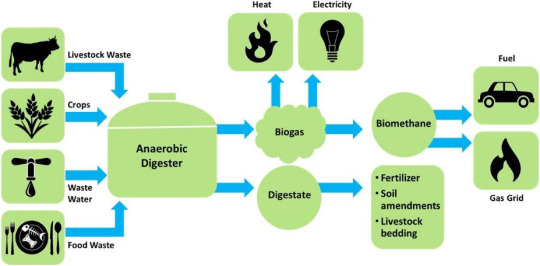
Since the biofuel is a gas, it needs to be converted to a liquid for transportation and use in engines. This is what the Fischer–Tropsch process is for.
The process itself involves fixing the hydrogen to carbon monoxide ratio, then applying heat and pressure to get liquid fuel.


The spherical gas container is called a Horton sphere, and what Senku says is correct, so the only thing missing is a video because everyone loves explosions.

This is a oxyhydrogen torch which is normally used for small-scale welding jobs as it's safer and more economical to use than gas torches.
You can also make them yourself.


Has Chrome's science-using officially leveled up? He's been working with Xeno while Senku works with Suika. The science mentor/mentee parallel here is really nice!


Inconel is actually a family of superalloys of oxidation-corrosion-resistant materials that are also very strong and very good at holding up to high temperatures. As such, it tends to be used in extreme environments like space.


"It's just a rock" is a common theme in Dr. Stone, but it matches the series extremely well. A single rock can't do much on its own, but with a little work and some team-ups, that rock can go to space :)



Since the calendar is between Chrome saying "half a year" and what looks like a time skip sequence, I think the date of April 5750 is somewhere in the middle rather than on either end, which isn't very helpful for a specific timeline.


This timeskip mimics the one in chapter 99 while they made the old Perseus, but is a lot shorter to add in the team and farewell portion of chapter 100.



Like last time, Ryusui helps with the design, Kaseki does the crafting (the part he's working on is the prow), while everyone else collects materials.
We also get the South American KoS flag, incorporating the spaceship with the concentric diamonds!




The engine here is a jet engine, Most commonly used in airplanes but have other uses as well. For this, the engine is usually used to generate electricity which then powers other things, such as boat propellers attached to electric motors.


(Next part)
7 notes
·
View notes
Text
“Northern Lights Out”

Season 7, Episode 12
First US Airdate: October 23, 1993
The Turtles battle a Viking warrior who plans to cause global flooding.
“Northern Lights Out” is the penultimate episode of the “Vacation in Europe” side-season of Teenage Mutant Ninja Turtles. Ted Pedersen and Francis Moss are the writers of this adventure, both making their final contributions to the series here.




April is picnicking with the Turtles in Oslo, Norway, and had made a point of asking the hotel to prepare some local cuisine for the occasion. The Turtles have intervened to ensure the meal ends up being a pizza, in this case with a Scandanavian theme: a sardine and lutefisk topping. Donatello isn’t convinced, not being a fan of fish.
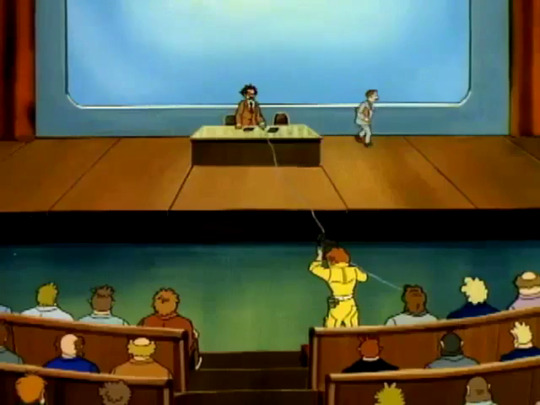






While in town, April attends an alternative energy conference. Donatello sits in as Professor Svenson addresses the audience, explaining that Norway rests on a series of mostly dormant volcanic pools; if their energy could be harnessed, it would provide the equivalent of half of Europe’s current power usage, generating enough electricity to light Oslo for a thousand years. The Professor is set to meet with government officials later that day to outline his proposal, but before he can do so, his speech is interrupted by a huge man in traditional Viking attire, introducing himself as Eric the Redeye, descendant of Thor. The axe-wielding warrior steals the Professor’s notes, easily defeats a group of security guards, and upon being quizzed by April for Channel 6, takes her hostage before escaping.






Losing his disguise, Donatello gives chase, charging through a glass window and falling from the second floor into a cart full of fish sitting on the street. As April watches on, Donnie and Eric size each other up but the fight ends abruptly when the damage caused to the building leads to bricks raining down upon them. Eric escapes with his men in a Viking motorcycle(?!) as the other Turtles arrive on the scene, frantically digging through the bricks while trying to free Donatello. The team are baffled when Donnie himself arrives to help, explaining that he dropped through a sewer opening and was never in danger.



Later, in their van, the Turtles watch a broadcast where April interviews Professor Svenson. She quizzes him as to whether Eric the Redeye could use the stolen notes for nefarious purposes, and with each question Svenson provides the same response: “Ya, sure, you betcha!” He eventually reveals that the notes on their own are useless, as only he knows the location of the volcanic pools in question. Figuring that this makes Svenson a target for a return visit from the Viking, the Turtles drive off to prepare for a counterattack.







As predicted, Eric arrives with a group of his men, taking Professor Svenson and April hostage. By the time the Turtles hit the scene they’ve quite literally missed the boat, watching as a solar-powered ship carrying the villains leaves the harbour. The Turtles source a boat of their own and follow closely behind, but are caught in a trap by Eric as act one ends, a mechanically operated chasm closing in on their ship.





Act two begins with the Turtles having lost their boat, now squeezed into small space on a cliff between the two sides of the chasm. Our heroes use grappling hooks to scale the chasm and watch as Eric’s ship sails away. Continuing to give chase by land, the Turtles head to a nearby farm; there, they find a pair of Elks, which they ride until they spot Eric’s ship pulling into a fjord. A concealed wall briefly opens to allow the boat inside, closing again moments later.




The Turtles consider how to get to Eric’s secret headquarters, with Donatello suggesting that there must be an air vent that could be used to gain entry. A bird happens to be seen getting sucked down into the ground, providing an indicator of where to go; later, the Turtles are seen descending via ropes. Below ground, they discover a Viking village and realise they’ll need to quickly source disguises.

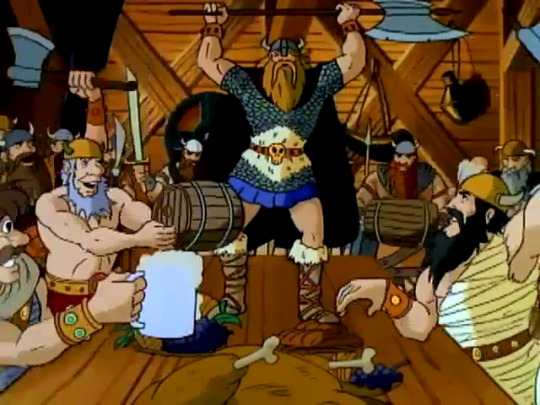
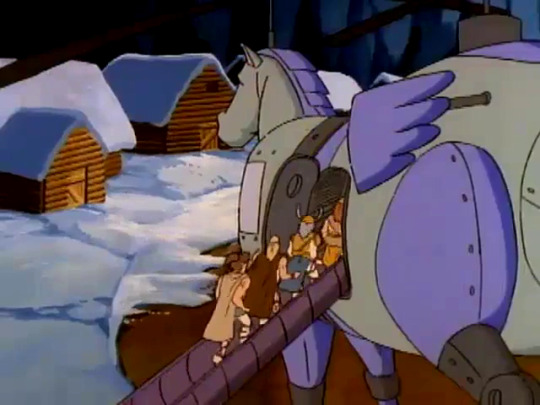




A captive April learns that Professor Svenson has provided Eric with the locations of the volcanic pools. The Viking leader leaves with a group of his men in a giant mechanical flying horse, giving orders that Svenson and “that wench” be monitored in his absence. April takes offense at being addressed in such a manner, her anger overheard by the Turtles who are now wandering through the village dressed as locals. A rescue attempt by the team is foiled when the Vikings see through their disguises, but an unlikely figure saves our heroes: an old lady who is insistent that the Turtles are “green dwarves”, responsible for fashioning Thor’s hammer. She declares that the green teens “have come to do Odin’s bidding”, leading to rejoicing from the villagers. The Turtles lean into this, ordering that April and the Professor be freed and requesting the use of their longship.





Later, in the solar-powered boat, Professor Svenson explains to April and the Turtles that Eric intends to blow up the volcanic pools; doing so will melt the polar ice cap, causing disastrous coastal flooding. In the resulting chaos, the Vikings will plunder the flooded cities. A further complication follows as the ship carrying our heroes is confronted by Jormungandr, a legendary Nordic sea monster. The creature begins chowing down on the boat, at one point sending Michaelangelo through the ship’s deck; Raphael quips that he “feels another cliffhanger coming on” as the boat is pulled into Jormungandr’s mouth, concluding the second act.







The final segment of the show opens with Donatello discovering that Jormungandr is actually a robot, launching himself into its throat and using his bo staff to jam its mechanisms. Abandoning the ship, the other Turtles, April and Professor Svenson join Donnie inside the robot. The group alter its course, heading for the volcanic pools, but Eric is already there, and learns that his creature has been captured by the Turtles. Activating a remote control, he locks the Turtles out of the sea serpent’s control room and has it hit the rocks, the resulting flooding threatening to finish off our heroes who remain trapped inside.






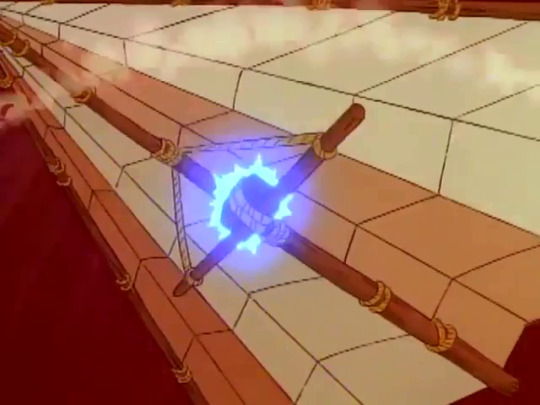
Donatello works quickly, implementing a plan to re-fashion the sails of the boat devoured earlier by Jormungandr into a set of solar-powered gliders. The Turtles arrive at the volcanic pools and confront the hordes of Vikings, with Donatello attempting to disable the bomb but facing resistance from Eric. A final confrontation unfolds between the two within the volcano, but Donnie was able to study the schematics of Thor’s supposed hammer while aboard Jormungandr and activates a device which vaporises it. (Throughout this episode the hammer has been drawn, confusingly, as an axe.) With the villain defeated, he goes on to send the detonator device into the air on one of the gliders, narrowly avoiding disaster.

With the day saved, the team reunite, Donatello noting how hungry he is after today’s events. April reveals that she saved him a slice of the fish pizza from the beginning of the episode, leading the team’s resident inventor to run off, repulsed.
“Northern Lights Out” might be the most action-themed episode of the European Vacation arc, consisting largely of a series of chase scenes. We get a small amount of breathing room when the Turtles discover the Viking village, but soon our heroes are on their way again. Pedersen and Moss are among the show’s most prolific contributors and make a point of giving the Turtles plenty of one-liners along the way, which helped a great deal in maintaining my interest.
Like “Artless” before it, this episode breaks from convention by introducing a new villain; this should be refreshing, but Jim Cummings voices Eric the Redeye here sounding almost identical to his substitute Shredder, which diminishes the novelty considerably. Eric reminds me of the jewel thieves from “April Gets in Dutch” in that his defeat feels rushed and unsatisfying; Donatello destroys his hammer and Eric simply falls to his knees before the story moves on to hurriedly tie up the remaining loose ends before the end credits roll.
One final episode of this arc remains! Next time the green teens return to London and travel back in time for a very special crossover of sorts in “Elementary, My Dear Turtle”.
#Teenage Mutant Ninja Turtles#TMNT#TMNT 1987#1992#1993#Ninja Turtles#Northern Lights Out#Eric The Red-Eye#Eric The Redeye#Turtlethon
2 notes
·
View notes
Text

Out of Time Chapter One Hundred and Twenty -nine
AO3
Jamie, Claire, and Juliaellen are the last to arrive. They arrive a week after Danny and his group. They are gathered at the harbor.
“Anyone get sea sick?” This produces a nervous laughter. Jamie knows it is a question he should have asked sooner. Secrecy to protect the vulnerable hadn’t allowed it.
“I have never been on a boat.” Asha offers.
“Nor me.” Adds Charlie.
“Well, I have meds to help in the case anyone needs them.”
“This is brilliant Jamie. Out in the middle of the Atlantic is a grand place to hide.” Jenny says. She holds a struggling Maggie in her arms. The lass wishes to, “see the water.” and isn’t taking no for an answer.
“Come here munchkin.” Jamie takes his niece, “we shall see the water. We are going to take a long boat ride.”
“Fishies! Fishies!”
“Aye, plenty of them.”
They have gathered the food stuff they can, a lot of fruit and vegetables, as Jamie doesn’t wish to treat rickets, but fish will be the main protein.
“We found the perfect boat.” Murtagh leads the group a way down the harbor. He stops in front of a huge yacht. “Figure we should travel in style. All the electric is solar powered so cooking and such shouldn’t be a problem. We can remove the radio and the chance of being traced. The petrol storage is massive, will want to fill it up.”
“Grand job Murtagh!” Jamie praises. “Your right. It is perfect.”
They get busy, nervous about being in one place to long. Petrol is gathered, the food and other supplies are loaded, finally the people are. Bunks are assigned, with keeping families together the priority.
“Oh boy.” Asha’s dark skin turns a bit grey as the yacht rocks.
“You alright, Asha?” Danny comes up behind her. She jumps, to focused on not being sick to hear him coming.
“No not really. We aren’t even moving yet!” occurs to her. Murtagh and Simon, both who have driven boats, are working on getting them going.
“No. Shall I fetch Jamie or take you down below?”
“No but thank you. Will you just stay with me a moment?”
“Of course.” He steps up beside her.
Charlie, doing better with the waves, watches from behind a pole. She doesn’t like it, them talking together, the two outsiders. An eye will be kept on them, especially Asha.
A week later, they are far away from land. The yacht rests, bobbing about as her passengers spend the days fishing off her sides, running after children ( Alex, to everyone’s surprise, is toddling about, as long as he has an object or person to hold on to), treating sea sickness and pregnancy, and planning.
“Come here to mama, Juliaellen.” The lass toddles over and grabs her knee. Maggie is sing songing a song she made up about the ocean. The lads are working on their lessons under the supervision of Charlie. The adults are gathered to discuss the Bonnet issue.
“Going after him is the best idea.” Murtagh rubs the back of his daughter, trying to rise wind.
“Exactly, we can’t keep running. We need to go on the offense.” Danny sits by Jenny, who is nursing Daniel.
“Alex no!” Mary’s strong exclamation has Murtagh raising and grabbing the young lad, who was crawling away from the group.
“You must stay by us, aye?”
“Aye daddy.”
All conversation stills. Even Maggie stops singing. “That’s new.” Jamie says as a wave rocks them. The briny smell of the ocean can’t hide the more nose twisting smell of a nappy.
“Aye.” His chest is puffed up with pride. “He just started that yesterday.”
“Not mama,” Mary reaches for her daughter, “let me take her so daddy can change his nappy.”
Murtagh pulls a face but willingly goes about the task. They are using cloth nappies. It is easier than running about trying to find the others, especially now. They line across the bow, making an extra sail.
“Right, where were we? Offensive . We must stop just responding.” Claire adjusts on the deck chair. At six months, she is uncomfortable in her body. Poor Heather is even worse at term. Jamie is carefully watching her.
“I agree but let’s get these babies born before doing anything else. I mean, we need to plan anyway. We don’t even know where he is.”
“I do, or did. He may have moved.” Asha answers Jamie’s challenge. She is doing slightly better with her sea sickness.
All turn to her, Jenny moving her blowing hair out of her face as she lifts Daniel up to burp him. Simon runs his wife’s back as she shifts uncomfortably.
“Aye?” Murtagh returning to the group after seeing to Alex, questions.
“It is a long sail. Cheyenne Mountain in America.”
“Where they made War Games?” Heather inquiries.
“What?” Charlie and her charges turn to them. “What is that?”
“You are so young. A movie from the 80’s,” Claire answers, “But yes. It is a bunker with the capacity to survive a nuclear hit, or so they say. It would be a good place to hide away.”
“Yeah, him and all the big wig elites went there. I don’t know that they still are.”
“That would be near impossible to penetrate.” Claire muses rubbing her pregnant belly.
“We may not have to. I have been thinking. There may be another way.” Murtagh says.
#my writing#outlander fanfic#out of time#chapter one hundred and twenty nine#jamie and claire#cannon divergence#outlander fandom#modern au
1 note
·
View note
Photo





On March 3rd 1883 three hundred inhabitants of the remote Shetland island of Foula were on the point of starvation as the first supply boat of the year reached the stormbound community.
Foula, often described as the “Edge Of The World” is our most remote inhabited island. It is situated in the Atlantic Ocean approximately 20 miles to the west of the Shetland mainland. It is an island of crofting townships, breath-taking sheer cliff drops, and a wealth of wild flowers and wildlife.
Over a century ago, in 1881, Foula had a population of 267, mostly employed in fishing…at the last census in 2001 that figure had dropped to just 38.
On March 3rd 1883 the Shetland Times published this;
The Weather and Mails – Foula
Nine weeks have now expired since our last mail was landed, and all our resources are almost exhausted. Sugar and tobacco have been all done for more than a fortnight, and tea, coffee, etc, are now done also. Those who had a little meal to spare have helped those who had none, a thing often done in Foula, but if the weather does not moderate we will soon be all alike. The boat has been in readiness now for some time to go to Walls for supplies, and as the weather has become a little more moderate today they are going to make a start, so we hope that they may get safe through, and a chance to return again soon. But we doubt if the mail boat will be able to cross today yet, as the wind still inclines to the westward.
There isn’t much more than this about their plight, but it seems that same day they breathed a sigh of relief as a boat must have made it to Mainland and back successfully.
Today crofting as well as fishing are the main activities, half the population living at Hametoun in the south east and the remainder to be found at Ham near Ham Voe on the east coast. The island is not connected to any mainland electricity grid system. In 1987 a community electricity scheme was constructed, comprising a 3.3kV island grid which linked diesel generators, a wind turbine and a hydroelectricity scheme to the island’s properties. This scheme gradually fell into disrepair and has undergone a major refurbishment, funded primarily through grants.
Before refurbishment, the entire island’s power was supplied by one of the two diesel generators which operated between approximately 7.20am and 00.30am. That’s not to say they were without power for the, just under 7 hours the generator is off, a battery/inverter system was installed between 2006 and January 2007, a solar charging array helps top up the batteries as well . The system was fully commissioned at the beginning of March 2007 and already the islanders not only have continuous power ( instead of the previous 17 hours per day) but are noticing considerable savings in diesel fuel use. Since diesel has to be shipped in by ferry (and often the weather is too bad for the ferry to run for up to 3 weeks on end) this of huge value.
An interesting feature of the island’s people is that they still observe the old Julian calendar, replaced in 1752 in Britain by the present Gregorian system which deleted 11 days from the year. Remote areas of the country kept to the old calendar, adding an extra day in 1800, which was a leap year, and some parts of Shetland continued to observe festivals 12 days after the dates in the new calendar. The most remote areas kept to the old calendar longest, and the people of Foula still celebrate Christmas on 6 January and New Year’s Day on 13 January
Travel to the island is by sea or air and is completely dependent on suitable weather conditions.
A wee bit more, and a short video can be found at the link below.
https://www.shetland.org/visit/plan/areas/foula
68 notes
·
View notes
Text
Stable electricity is essential to patient care, enabling health workers to run medical devices like heart monitors, quickly heat water to disinfect surgical tools, and refrigerate medications and vaccines.
Electricity has been one of the major challenges for health centers in Masisea and Iparia, rural communities in the Amazon rainforest, reachable only by boat. More than 12,000 people live in these communities, representing 87 indigenous groups, such as the Asháninka and the Shipibo-Konibo.
The panels installed by Socios En Salud store this energy in a battery, ensuring electricity is available even on cloudy days. As part of its efforts to strengthen health systems sustainably and for the long term, Socios En Salud trained clinic staff on how to maintain the solar panels and their batteries.
Ever since the panels were installed, they’ve been powering the health centers in more ways than one.
“Now, patient demand is more regular,” says Mónica Córdoba Macuy, an obstetrician at Masisea Health Center. “Before it was not much.”
The stable, 24/7 electricity supplied by the solar panels has directly impacted care for at least 1,200 patients in Masisea.
“Now that they’ve put in solar panels for 24-hour lighting, that helped us a lot,” says Vázquez. “It’s the first time in my life since I was born that I’ve seen lights 24 hours a day.”
9 notes
·
View notes
Text
Been playing with Replicate’s text-to-Pokémon AI art generator today, and been inventing some new Pokémon for fun. I thought it’d be fun to then take my favourite designs and write up some Fakémon descriptions for them. Usually I just went with the first result, or else you just spend too long trying to perfect an idea and lose what was already good. The AI seems to really like disk-shaped things for unknowable entities (half the Lovecraftian creatures I tried came back as symbolic disks), and it also draws on Vivillon quite heavily, to the point where “exotic butters” just returned actual Vivillon images with little change.
Gonna put a linebreak here since this could be a long post~

Prompt: “wetlands ghost”
Name: Fentasm
Type: Ghost/Water
Description: A friend to those lost in the foggy marshlands, this mysterious Pokémon appears when the moon breaks through the fog to guide travelers along a safe path.

Prompt: “SipsCo Dirt Factory”
Name: Dirtpyle
Type: Ground
Description: A Pokémon used as a diligent factory worker. Its ability to compress, compact, and store dirt into neat cubes makes it valuable in agricultural work.

Prompt: “cheeseburger”
Name: Bugcheeser
Type: Bug/Normal
Description: This strange Pokémon has a strong smell of a fast food restaurant! Strangely meaty and soft for a Bug-type, it conceals a large mouth underneath its brown shell. This Pokémon is a common sight in urban areas.

Prompt: “the spirit of halloween”
Name: Hallowraith
Type: Ghost/Dark
Description: A shadowy Pokémon that appears in late autumn, just after the harvest season. Originally feared for its appearance, people later celebrated it as a sign of the colder weather coming and held celebrations in its name. It may accept offerings of candy.

Prompt: “Cthulhu”
Name: Lurkrafter
Type: Poison/Water
Description: A slumbering titan deep under the ocean, many legends tell of the fearful day it may wake. Despite its sturdy looks, it is actually quite soft and has been bruised by boats passing over its napping area.

Prompt: “mars rover”
Name: Rover Rotom
Type: Electric/Steel
Description: This Rotom form is used to explore hostile environments. Its large tires allow it to climb rough surfaces with ease, and it collects solar energy with its panels to keep itself powered up. It communicates remotely with its owner.

Prompt: “Ghostbusters”
Name: Bustrinos
Type: Normal
Description: Often seen in groups, even a single Bustrinos is a match for any Ghost-type. Each variety brings a unique skill to their fight against ghostly opponents, including a tracking ability, an electrical discharge, and a mood-altering slime.

Prompt: “hastur”
Name: Yelloking
Type: Dark
Description: This mysterious disk-like Pokémon is spoken about only in hushed whispers, as it’s said invoking its name can bring its attention. It is instead usually referred to with a drawing of the yellow sign in the middle of its body.

Prompt: “rock-type pretending to be a tree”
Name: Conifraud
Type: Rock/Grass
Description: A distant relation of Sudowoodo that has taken its disguise far enough to actually become part Grass-type. This Pokémon is almost impossible to spot at a distance. Cut does not work on it.

Prompt: “arin hanson”
Name: Grumpanzee
Type: Ground/Fighting
Description: A sturdy Pokémon with a lot of power, it is unfortunately impatient and easily distracted. Its luxurious mane protects it from being struck from behind while it is bragging about its strength.

Prompt: “dan avidan”
Name: Luchadan
Type: Normal/Fighting
Description: Charming and easygoing, this Pokémon is a talented musician with the aid of its third arm. It is often seen in the company of Grumpanzee, where it keeps its grumpy companion on track.
3 notes
·
View notes
Text
Navigating Power Solutions for Construction Sites

Construction sites thrive on efficiency, demanding reliable power solutions to maintain seamless operations. From fueling heavy machinery to illuminating work areas, a consistent energy source is indispensable for project progress. With an array of options available, selecting the ideal power solution tailored to specific project needs can be daunting. In this guide, we'll explore diverse power solutions for construction sites, weighing their advantages, drawbacks, and aiding in informed decision-making for upcoming projects.
Gas Engines and Generators:
Gas engines and generators emerge as favored power solutions for construction sites, prized for their reliability, efficiency, and cost-effectiveness. By converting fuel into mechanical energy, they power generators to produce electrical energy, catering to projects of varying scales. Notably, their eco-friendly nature, marked by lower emissions compared to diesel generators, underscores their appeal. However, the initial investment may pose a challenge, albeit outweighed by long-term benefits, positioning gas engines and generators as viable alternatives to traditional power sources.
Oil & Gas Engines and Generators:
Oil and gas engines, coupled with generators, wield considerable influence in the construction realm, revered for their reliability, efficiency, and robust performance. Fueled by fossil fuels, they drive heavy-duty machinery crucial for construction projects. Meanwhile, the versatility of generators in providing temporary power solutions underscores their utility. However, navigating their limitations is paramount to ensure alignment with project-specific requisites.
Diesel Generators:
Diesel generators stand as stalwarts of reliability and portability, serving as indispensable power sources for construction sites. Offering swift electricity generation for on-site tools and equipment, they excel in remote areas devoid of grid power access. Despite emitting more noise, their extended lifespan and minimal maintenance requirements render them cost-effective and efficient, making them a preferred choice for construction endeavors.
Industrial Engines:
Industrial engines play a pivotal role in powering construction sites, enabling the operation of heavy equipment with unwavering reliability. From bulldozers to cranes, these engines exhibit resilience and endurance, capable of withstanding demanding working conditions. Their ability to generate substantial torque makes them indispensable across industries, including construction, agriculture, and mining.
Marine Engines and Generator Sets:
Marine engines and generator sets serve as linchpins in ensuring uninterrupted power supply across construction projects. Engineered for harsh marine environments, marine engines power boats and ships with tenacity. Generator sets, on the other hand, furnish transient or backup power solutions to construction sites, fueled by diverse sources. Their scalability, ranging from portable units to stationary installations, underscores their indispensability in construction settings.
FG Wilson:
FG Wilson emerges as a frontrunner in providing power solutions for construction, offering a diverse range of generator sets and related products. With over 50 years of industry experience, FG Wilson prioritizes reliability, durability, and efficiency in its solutions, ensuring uninterrupted project operations. Customizable to meet specific project requirements, FG Wilson's offerings epitomize excellence in power generation, earning the trust of construction professionals worldwide.
Solar Power:
Solar power emerges as a beacon of sustainability in construction endeavors, harnessing sunlight to generate clean energy. With photovoltaic panels becoming increasingly efficient and affordable, solar power presents a viable alternative to traditional power sources. Particularly advantageous in remote locations, it significantly reduces carbon emissions and lowers long-term energy costs. Its appeal to environmentally conscious builders underscores its relevance in modern construction practices.
In conclusion, the multitude of power solutions available for construction projects offers flexibility, each with its unique benefits and considerations. From traditional generators to renewable sources like solar power, selecting the optimal solution necessitates meticulous evaluation of project requirements and environmental impact. Armed with insights from this guide, stakeholders can navigate the power solution landscape with confidence, ensuring successful and sustainable construction projects.
0 notes
Text
Unleashing The Power Of The Sun: The Benefits Of Flexible Solar Panels For Sustainable Energy Solutions
Picture this: a world where sustainable energy solutions are a dream and a reality. Imagine harnessing the sun's power flexibly and innovatively to create clean, renewable energy. Welcome to the era of flexible solar panels! This blog post will delve into the advantages, environmental benefits, applications, challenges, and economic advantages of using flexible solar panels. Get ready to be amazed at how these cutting-edge technologies revolutionize our thoughts on solar energy. Flexible Solar Panel
Advantages of Flexible Solar Panels
Flexible solar panels offer many advantages that set them apart from traditional rigid panels. One key benefit is their versatility - these panels can be easily integrated into various surfaces such as curved roofs, vehicles, or backpacks. Their lightweight and slim profile makes them ideal for applications where weight and space are critical factors.
Another advantage of flexible solar panels is their durability. Unlike glass-based counterparts, these panels are typically made with robust materials like polymer substrates that can withstand bending and flexing without compromising efficiency. This makes them suitable for installations in challenging environments where rigid panels may not be practical.
Furthermore, flexible solar panels are portable and easily transported, perfect for off-grid adventures or temporary power needs. As advancements in technology enhance efficiency levels, these panels continue to gain popularity in residential and commercial settings alike.
Environmental Benefits of Using Flexible Solar Panels
Regarding sustainable energy solutions, flexible solar panels offer a range of environmental benefits that make them a compelling choice for eco-conscious individuals and businesses. One significant advantage is their low carbon footprint compared to traditional energy sources. These panels produce clean electricity by harnessing the sun's power without emitting harmful greenhouse gases into the atmosphere.
Additionally, flexible solar panels require minimal water usage during operation, unlike fossil fuel-based power plants that rely on large quantities of water for cooling. This conserves precious water resources and reduces the strain on local ecosystems. Furthermore, by generating renewable energy on-site, these panels help decrease reliance on non-renewable sources like coal and natural gas, contributing to overall reductions in air pollution and mitigating climate change impacts.
The lightweight and versatile design of flexible solar panels also allows for easy integration into various structures and surfaces, promoting space-efficient installations deployed in urban environments or remote locations with limited access to conventional power grids. As more individuals and organizations embrace this innovative technology, its positive impact on the environment will grow exponentially.
Applications and Uses of Flexible Solar Panels
Flexible solar panels offer various applications and uses, making them versatile and adaptable for multiple situations. One everyday use is in residential settings, where they can be easily integrated into rooftops or even curved surfaces, providing an aesthetically pleasing and efficient way to harness solar energy.
In addition to homes, flexible solar panels are utilized in off-grid locations such as cabins or RVs, offering a portable and lightweight power source. Their flexibility allows for easy installation on unconventional surfaces like boats or backpacks, enabling users to generate electricity while on the move.
Moreover, these innovative solar panels are ideal for military operations due to their durability and ability to withstand harsh conditions. They can also be used in disaster relief efforts to provide quick access to renewable energy in emergencies.
The applications of flexible solar panels continue to expand as technology advances, offering sustainable energy solutions across diverse industries.
Challenges and Solutions for Wider Adoption
One of the main challenges hindering the widespread adoption of flexible solar panels is their initial cost compared to traditional energy sources. Many individuals and businesses are hesitant to invest in renewable energy due to perceived high upfront expenses.
Another challenge is the limited efficiency of some flexible solar panel technologies, which can impact their effectiveness in generating electricity. This issue has led to concerns about whether these panels can genuinely meet consumers' energy demands.
To address these challenges, ongoing research and development efforts are focused on improving the efficiency and affordability of flexible solar panels. Innovations such as new materials, manufacturing techniques, and storage solutions aim to make these panels more accessible and efficient for a broader range of applications.
By overcoming these obstacles through innovation and technological advancements, we can pave the way for greater future adoption of flexible solar panels as a sustainable energy solution.
Economic Benefits and Cost Savings of Flexible Solar Panels
As we delve into the economic benefits and cost savings of flexible solar panels, it becomes evident that investing in this sustainable energy solution is both environmentally friendly and financially wise. The initial investment may seem significant, yet over time, the savings on electricity bills and potential government incentives can make a compelling case for choosing flexible solar panels.
By harnessing the sun's power with these innovative technologies, individuals and businesses alike can reduce their carbon footprint while enjoying long-term financial advantages. The versatility and adaptability of flexible solar panels open up possibilities for integrating renewable energy sources into various settings, paving the way for a greener future.
Embracing flexible solar panels as part of our sustainable energy solutions holds tremendous promise for our planet and our pockets. Let's unlock the full potential of these cutting-edge technologies to create a more sustainable and eco-friendly world for generations to come.

0 notes
Text
The Benefits of Solar Dock Lights for Boat Owners
Solar dock lights offer numerous benefits for boat owners by providing reliable, cost-effective illumination without the need for external power sources. These lights enhance safety by illuminating docks and pathways, preventing accidents during nighttime boating activities. Solar dock lights are eco-friendly, reducing energy consumption and environmental impact. They are also low-maintenance and durable, designed to withstand harsh weather conditions, making them a practical and sustainable choice for any boating enthusiast.
Enhanced Safety with Solar Dock Lights
Solar dock lights significantly enhance safety for boat owners. By providing consistent and bright illumination, these lights ensure that docks and pathways are clearly visible during nighttime. This reduces the risk of accidents, such as tripping or slipping, and makes docking and navigating around the boat easier and safer. The improved visibility also helps in identifying potential hazards, such as obstacles in the water, which is crucial for preventing damage to boats and docks.
Cost-Effectiveness of Solar Dock Lights
One of the primary benefits of solar dock lights is their cost-effectiveness. These lights harness solar energy, eliminating the need for electricity from the grid and reducing energy bills. The initial investment in solar dock lights is offset by the long-term savings on electricity costs. Additionally, since solar dock lights require minimal maintenance and have a long lifespan, they prove to be a financially sound investment for boat owners.
Environmental Benefits of Solar Dock Lights
Solar dock lights are an eco-friendly lighting solution, contributing to environmental conservation. By using renewable solar energy, these lights reduce reliance on fossil fuels, thereby decreasing greenhouse gas emissions and air pollution. This environmentally responsible choice helps boat owners minimise their carbon footprint and supports broader efforts to combat climate change. Furthermore, solar dock lights do not require wiring or electrical connections, reducing environmental disruption during installation.
Low Maintenance and Durability of Solar Dock Lights
The low maintenance and durability of solar dock lights are significant advantages for boat owners. These lights are designed to withstand harsh weather conditions, including heavy rain, strong winds, and saltwater exposure. Made from durable materials, they resist corrosion and damage, ensuring longevity. Additionally, solar dock lights typically come with rechargeable batteries that last for several years, reducing the need for frequent replacements and maintenance efforts.
Easy Installation of Solar Dock Lights
Installing solar dock lights is a straightforward process that does not require professional assistance. Since they are wireless and self-contained, there is no need for complex wiring or electrical work. Boat owners can easily install these lights on their docks, pathways, or other areas without specialised tools or skills. This ease of installation makes solar dock lights a convenient and practical choice for enhancing dock illumination quickly and efficiently.
Aesthetic Appeal of Solar Dock Lights
Beyond their functional benefits, solar dock lights also enhance the aesthetic appeal of docks and marinas. These lights come in various designs, colours, and styles, allowing boat owners to customise their docks' appearance. The soft, ambient glow of solar dock lights creates a welcoming and visually pleasing atmosphere, making the dock area more attractive and enjoyable for evening and nighttime activities.
Increased Property Value with Solar Dock Lights
Investing in solar dock lights can also increase the value of a property. Well-lit docks and waterfront areas are appealing features for potential buyers, as they enhance safety, functionality, and aesthetics. The eco-friendly nature and cost-saving benefits of solar dock lights further add to their appeal. For boat owners looking to sell their property, the presence of high-quality solar dock lights can be a valuable selling point that attracts environmentally conscious and safety-minded buyers.
Conclusion
solar dock lights offer a range of benefits for boat owners, from enhancing safety and reducing costs to providing environmental advantages and increasing property value. Their low maintenance, durability, and easy installation make them an ideal lighting solution for docks and marinas. Additionally, the aesthetic appeal and eco-friendly nature of solar dock lights contribute to a more enjoyable and sustainable boating experience. By investing in solar dock lights, boat owners can enjoy a well-lit, safe, and beautiful dock area while making a positive impact on the environment.
0 notes